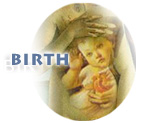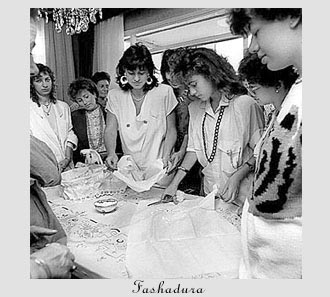|


Ashkenazi Jews in
the shtetl believed that proud talk when a pregnancy was barely
established would invite catastrophe. Like other Jews, they feared the
Evil Eye, expecting it to do harm when their affairs were prospering…
[Even today, many] buy nothing for an expected infant until after the
birth.[1]
In contrast, Sephardic Jews have often celebrated a first pregnancy.
This celebration has been named kortadura de fashadura (in Judeo-Spanish)
or tekti'a el g'daouere (in Judeo-Arabic), meaning "the cutting
of the swaddling clothes."

At
the Fyesta de Fashadura held in honor of the expected baby of Ece
Mizrahi.
Photo: Laurence Salzmann*
The ceremonial
cutting of cloth to make the baby's first costume, which is the same for
a girl or a boy, is an old Sephardic custom still continued by some Jews
in Istanbul. When a Jewish woman reaches the fifth month of her first
pregnancy, her family invites all her female relatives and in-laws, as
well as friends and neighbors. Liqueurs and chocolates, tea, cakes and
sugared almonds are set out on the best china, on hand-embroidered tablecloths.
The cloth is of excellent quality and traditionally comes from the expectant
woman's dowry. A relative who is herself a mother and whose own parents
are still alive (a good omen for long life) receives the honor of making
the first cut in the cloth. At the moment of the cut, the pregnant woman
throws white sugared almonds on the cloth to symbolize the sweet and prosperous
future she wishes for her future child.[2]
… In Morocco, the midwife cut the cloth into swaddling clothes in
the presence of women friends and relatives who offered their good wishes
and shared tea and cakes.[3]
| On
a recent trip to Turkey, culinary researcher and cookbook author Claudia
Roden found that the fashadura, is still being celebrated.
The menu featured Borekitas
de Berengena — Eggplant and Cheese Pies, a dish unique,
in Turkey, to the Jewish community.[5] |
Apparently, this was
a very festive occasion, for in 1904 the rabbi of Sefrou decreed against
the ostentation displayed at these celebrations.[4]
When the conception followed a period of barrenness that had been cured
by a pilgrimage to the tomb of a famous rabbi, the pregnant woman returned
to the tomb for a celebration of cakes and arrak, and she distributed
charity to yeshivah students and the poor. By the middle of the
twentieth century, a few Jewish families still continued these traditions,
fearing bad luck if, by abandoning them, they omitted the blessings and
good wishes for the future child.
 |
[1]
Goshen-Gottein,
E. Marriage and First Pregnancy (London:Tavistock, 1966).
[back]
[2]
Lorenzo
and Ayse Salzmann, and Eti Alkanli of California, personal communication.
[back]
[3]
Ben
Simhon, R., Yahadut Marocco (Lod: Orot Yahadut Magreb,
1994) pp. 19, 28-29. [back]
[4]
 Ovadia,
D. Kehillot Zafro, (Jerusalem: 1975), vol. 1, p. 293. [back] Ovadia,
D. Kehillot Zafro, (Jerusalem: 1975), vol. 1, p. 293. [back]
[5]
Claudia
Roden. The Book of Jewish Food,. © copyright 1996 Claudia
Roden (New York: Alfred A. Knopf), pp. 283-84. [back]
|
 |
From:
Michele Klein, A Time to be Born: Customs and Folklore of Jewish
Birth. © copyright 1998 by Michele Klein (Philadelphia: Jewish
Publication Society of America), pp. 70-71. Permission of the author
and Jewish Publication Society of America.
|
|
 |
Photograph
courtesy of photographer Laurence Salzmann, Blue
Flower Press. |
|



